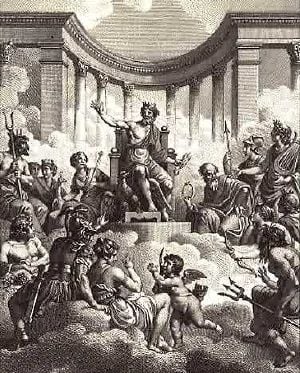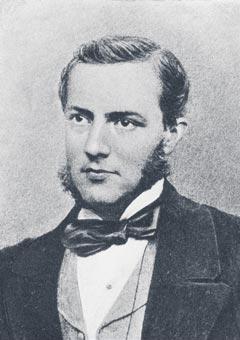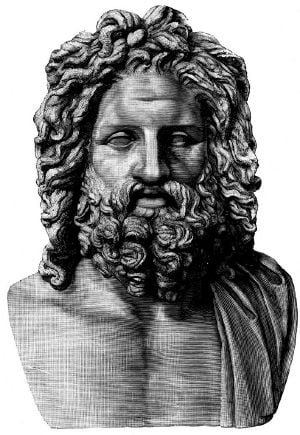
The term Greek mythology refers to the collection of tales belonging to the ancient Greeks concerning their pantheon of gods as well as their heroes, which outline their own cultic and ritual practices and view of the world. This corpus of material includes a large collection of narratives, some of which explain the origins of the world, and others that detail the lives and adventures of a wide variety of gods, goddesses, heroes, heroines, and other mythological creatures. These accounts were initially fashioned and disseminated in an oral-poetic tradition, though they are known today primarily through written Greek literature.
Greek mythology has exercised an extensive and profound influence on the culture, arts and literature of Western civilization. Indeed, Greek mythological themes have remained continually relevant throughout western literary history.[1] Though the ancient Greek religions based upon these tales have long since faded into obscurity, Greek myths remain the archetypal sources for much of Western fiction, poetry, film and visual art. Greek mythology has played a pivotal role in the development of modern studies of mythology, psychology, and philology, and it continues to be a part of the heritage and language of the global community.
Etymology
While all cultures throughout the world have their own myths, the term mythology itself is a Greek coinage, having a specialized meaning within classical Greek culture. Specifically, the Greek term mythologia is a compound of two smaller words:
- mythos (μῦθος)—Classical Greek, roughly "the oral speech," "words without action" (Aeschylus: "ἔργῳ κοὐκέτι μύθῳ," “from word to deed”)[2] and, by expansion, a "ritualized speech act," as of a chieftain at an assembly, or of a poet or priest, or a narration (Aeschylus: Ἀκούσει μῦθον ἐν βραχεῖ λόγῳ, “The whole tale you will hear in brief space of time.”).[3]
- logos (λόγος)—which in Classical Greek stands for: a) the (oral or written) expression of thoughts and b) the ability of a person to express his thoughts (inward logos).
Sources of Greek mythology
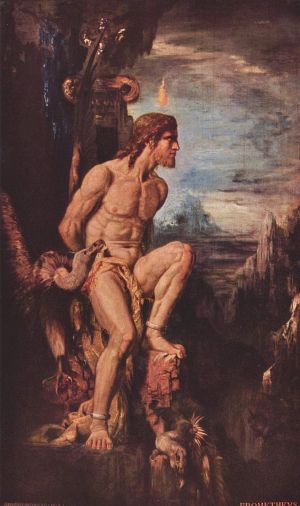 Prometheus (Gustave Moreau, 1868)—The myth of Prometheus was first attested by Hesiodus and then constituted the basis for a tragic trilogy of plays, possibly by Aeschylus, consisting of Prometheus Bound, Prometheus Unbound and Prometheus Pyrphoros |
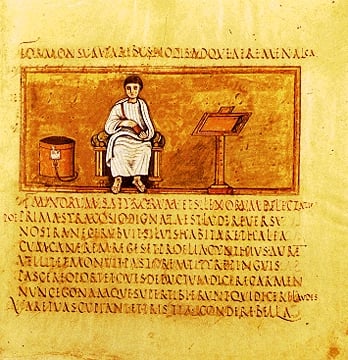 The Roman poet Virgil, depicted here in the fifth-century manuscript Vergilius Romanus, preserved details of Greek mythology in many of his writings |
The Greek myths are known today primarily from Greek literature. However, in addition to the written sources, there are mythical representations on visual media dating from the Geometric period (c. 900-800 B.C.E.) onward.[4]
Literary sources
Despite the oral-poetic origins of Greek mythology, the modern understanding of this tradition has been largely based upon the surviving textual remains of the classical period. The oldest known literary sources, Homer’s epic poems the Iliad and the Odyssey, focus on events surrounding the Trojan War. Two poems by Homer's near-contemporary Hesiod, the Theogony and the Works and Days, contain accounts of the genesis of the world, the succession of divine rulers, the succession of human ages, the origin of human woes, and the origin of sacrificial practices. Myths are also preserved in the Homeric hymns, in fragments of epic poems of the Epic Cycle, in lyric poems, in the works of the tragedians of the fifth century B.C.E., in writings of scholars and poets of the Hellenistic Age and the Roman Empire (for example, Plutarch and Pausanias).
As mentioned above, the earliest literary sources of the Greek mythical tradition are Homer's two epic poems, the Iliad and the Odyssey. These two accounts provide a clear indication of the Greek appetite for fantastic tales, as well as their understanding of the complex, often antagonistic relationship between men and gods (and between the gods themselves).
Hesiod, a possible contemporary of Homer, offers in the Theogony (Origin of the Gods) the fullest account of the earliest Greek myths, dealing with folktales, etiological tales, creation accounts, and descriptions of the origin of the gods, Titans and giants (including elaborate genealogies). His other notable production, Works and Days, a didactic poem about farming life, also includes the myths of Prometheus, Pandora and the Four Ages. In it, the poet gives advice on the best way to succeed in a dangerous world rendered yet more dangerous by its gods.[5]
Likewise, the lyrical poets (composers of the Homeric hymns) often took their subjects from myth, though their treatments gradually became less narrative and more allusive.[6] These lyric poets, including Pindar, Bacchylides, Simonides, and the later bucolic poets, such as Theocritus and Bion, provided individualized depictions of mythological incidents.[7]
Myth was also central to classical Athenian drama. The tragic playwrights Aeschylus, Sophocles and Euripides took their plots from the age of heroes and the Trojan War. Many of the great tragic stories (i.e. Agamemnon and his children, Oedipus, Jason, Medea, etc.) took their classic form in these tragic plays. For his part, the comic playwright Aristophanes also used myths, as in The Birds or The Frogs, though he typically used them as a means of critiquing Greek society.[6]
Historians (Herodotus and Diodorus Siculus) and geographers (Pausanias and Strabo), who traveled around the Greek world and noted the stories they heard, supplied numerous local myths, often providing little-known, alternative versions.[7]
Finally, the poetry of the Hellenistic and Roman ages, though composed as a literary rather than cultic exercise, contains many important details that would otherwise be lost. This category includes the works of:
- The Hellenistic poets Apollonius of Rhodes, Callimachus, Pseudo-Eratosthenes and Parthenius
- The Roman poets Ovid, Statius, Valerius Flaccus and Virgil
- The Late Antique Greek poets Nonnus, Antoninus Liberalis and Quintus Smyrnaeus
- The ancient novels of Apuleius, Petronius, Lollianus and Heliodorus
Archaeological sources
In addition to the textual sources described above, the modern understanding of Greek mythology has also been refined through archaeological exploration. The discovery of the Mycenaean civilization by German amateur archaeologist Heinrich Schliemann in the nineteenth century, and the discovery of the Minoan civilization in Crete by British archaeologist, Sir Arthur Evans, in the twentieth century, have helped to explain many questions about Homer's epics and have provided archaeological support for many mythological claims about Greek life and culture.[5] The visual representations of mythical figures discovered at these (and other) archaeological digs are important for two reasons: on one hand, visual sources sometimes represent myths or mythical scenes that have not survived in any extant literary source. For example, archaeologists have found pottery (dated to the eighth century B.C.E.) that depicts unknown scenes from the Trojan cycle and from the adventures of Heracles.[5] On the other hand, pictorial depictions of many mythic events can also predate their inclusion in literary sources, which allows students of classic Greek culture to assess the dates of their composition more accurately. In some cases, these visual representations predate a myth's first known representation in archaic poetry by several centuries.[4] In both ways, archaeological finds that include depictions of mythological scenes can be seen to supplement the existing literary evidence.
Survey of Mythic History
Historical Development of Greek Mythology
The mythological world postulated by ancient Greek thinkers evolved in tandem with their overall cultural system. The earliest known inhabitants of the Balkan Peninsula were an agricultural people who animistically assigned spirits to various features of the natural world. Eventually, in a process mirroring the development of polytheism elsewhere in the world, these spirits began to assume human forms and to enter the local mythology as gods and goddesses related to the agrarian lifestyle of these early people. When these territories were invaded by tribes from the north, the attackers brought with them a new pantheon of gods, based on conquest, force, prowess in battle, and violent heroism. Many of the older pastoral/fertility deities fused with those of the more powerful invaders, became incorporated into the pantheon, or else faded into insignificance. This syncretic process created the cultural-narrative system that survives into the modern day as classical Greek mythology.
However, this system underwent another sea change under the literary mythographers of the early Roman Empire, who preserved and propagated Greek myths after the collapse of native Hellenic society. However, in doing so, they often adapted the stories in ways that did not reflect earlier beliefs. Many of the most popular versions of these myths emerged from these inventive re-tellings, which may blur our modern understanding of the archaic beliefs.
Mythic Chronology
The achievement of epic poetry was to create cycles of stories and, resultantly, to develop a sense of mythical chronology. When thus contextualized, Greek mythology unfolds as a description of the emergence of the gods, the world and humanity.[8] While self-contradictions in the stories make an absolute timeline impossible, an approximate chronology dividing history into three or four broad periods may be discerned:
- The myths of origin or age of gods (Theogonies, "births of gods"): stories about the origins of the world, the gods, and the human race.
- The age when gods and mortals mingled freely: stories of the early interactions between gods, demigods, and mortals.
- The age of heroes (heroic age), where divine activity was more limited. The last and greatest of the heroic sagas are the stories surrounding (and immediately following) the Trojan War (which is regarded by some researchers as a fourth (and separate) period).[6]
While the age of gods has often been of more interest to contemporary students of myth, the Greek authors of the archaic and classical eras had a clear preference for the age of heroes. For example, the heroic Iliad and Odyssey dwarfed the divine-focused Theogony and Homeric Hymns in both size and popularity. Under the influence of Homer, the "hero cult" led to a restructuring of spiritual life, expressed in the separation of the Olympian from the Chthonic, of the realm of the gods from the realm of the dead (the Elysian Fields, which were reserved for deceased heroes).[9]
Regardless, the historical schema postulated above is visible in Hesiod's Works and Days, which makes use of a chronological division into Four Ages: Golden, Silver, Bronze, and Iron. These ages each have distinct foci, with the Golden Age belonging to the reign of Cronus, the Silver to the creation of Zeus, and the later Bronze period to the Age of Heroes. The final age (Iron) is seen by Hesiod as his own era, which he regarded as the worst (in terms of morality and quality of life).[10] This "Four Age" periodization is followed in Ovid's Metamorphoses.[11]
Age of gods
Cosmogony and cosmology
Cosmogonic and cosmological myths (concerned with the origins and nature of the universe) represent an attempt to render the natural world comprehensible in human terms.[7] The most widely accepted account of these origins is found in Hesiod's Theogony, which postulates that creation began from Chaos, a yawning nothingness. Out of this void emerged Ge or Gaia (the Earth) and some other primary divine beings: Eros (Love), the Abyss (Tartarus), and Darkness (Erebus).[12] Without any male involvement, Gaia gave birth to Uranus (the sky) who then proceeded to fertilize her. From that union were born the Titans (including Zeus's father, Cronus), the one-eyed Cyclopes and the Hecatonchires ("Hundred-Handers"). Cronus ("the wily, youngest and most terrible of [Gaia's] children"[12]) castrated his father and became the ruler of the gods, with his sister-wife Rhea as his consort and the other titans as his court. Eventually, Cronus was unseated by his son Zeus in an epic battle (the Titanomachy), which resulted in the triumph of the Olympians and the banishment of Cronus and the Titans to the depths of Tartarus.[13]
The earliest Greek aesthetic thought considered theogony (myths of the origins of gods) to be the prototypical poetic genre—the prototypical mythos (myth)—and imputed almost magical powers to it. Orpheus, the archetypal poet, was also the archetypal singer of theogonies, which he uses to calm seas and storms, and to move the stony hearts of the underworld gods in his descent to Hades. When Hermes invents the lyre in the Homeric Hymn to Hermes, the first thing he does is sing the birth of the gods.[14] Hesiod's Theogony is not only the fullest surviving cosmic origin story, but also the fullest surviving account of the archaic poet's function. Theogony, as a genre, was the subject of many poems, though the vast majority of them have been lost, including those attributed to Orpheus, Musaeus, Epimenides, Abaris and other legendary seers. These poems, which were of tremendous significance in ancient Greek religion, were used in private ritual purifications and mystery-rites. These rites (and the religious poems pertaining to them) were so central to Greek religious thought that traces of them can be found in the writings of Plato and the later Neoplatonist philosophers.<re>Gábor Betegh, The Derveni Papyrus (Cambridge University Press, 2004, ISBN 0521801087).</ref>
Greek gods
After the overthrow of the Titans, a new pantheon of gods and goddesses emerged. Among the principle Greek deities were the Olympians (who resided atop Mount Olympus under the watchful eye of Zeus), and various (likely more ancient) gods of the countryside, including the goat-god Pan, satyrs, the Nymphs, the Naeads (who dwelt in springs), the Dryads (who dwelt in trees), the Nereids (who inhabited the sea), and various gods of rivers and other landscape features. Some of the most important deities from the "Silver Age" (as attested in both surviving mythic literature and archaeological evidence) include Zeus, the sky god and ruler/patriarch of the pantheon; Hera, the divine wife of Zeus, who is often driven to jealous rages by her husbands philandering; Hades, the god of the underworld; Poseidon, the god of seas, rivers and earthquakes; Demeter, the goddess of fertility; Apollo, the god of prophesy, music, healing, disease and medicine; Athena, the goddess of wisdom, the crafts (especially weaving, pottery and carpentry) and defensive war; Hephaestus, the god of fire, artisans, and blacksmiths; Ares, the god of offensive war and slaughter; Aphrodite, the goddess of love, sexuality, and attraction; Hermes, the god of boundaries (and transgressing them); Hestia, the goddess of home and hearth; and, Dionysus, the god of wine, vegetation, and male fertility.[15]
As noted by famed classicist Walter Burkert, these Olympian deities were understood anthropomorphically: as they were seen as "persons, not abstractions, ideas or concepts."[9] However, despite their predominantly human forms, the ancient Greek gods did possess many fantastic abilities, including immunity from disease, eternal youth, and superhuman stamina and resilience.[15]
The second (or "silver") age of the mythic chronology is concerned with the ahistorical (i.e. pre-human) interactions between these deities. Each of the major gods and goddesses was the subject of a complex of myths, which detailed their origins, roles and responsibilities, relationships with other deities, and their interactions with the human populace. Indeed, Gregory Nagy regards "the larger Homeric Hymns as simple preludes [to the large-scale cosmological theorizing of Hesiod's Theogony], each of which invokes one god." [16] Those deities that captured the Greek imagination, such as Apollo and Dionysus, figured into numerous mythical tales and, consequently, come to possess complex personalities and to become patrons for a variety of human and worldly concerns. Those deities that did not, such as Hestia (literally "hearth") and Helios (literally "sun"), were relegated to being little more than personifications of abstract themes or phenomena. Many of the Silver Age tales provided etiological explanations for worldly phenomena (i.e. the myth of Persephone's death and resurrection as explication of seasonal variations in weather), while others (like the tale of the marriage between the disfigured dwarf Hephaestus and the comely Aphrodite) existed more for entertainment than edification.
Age of gods and men
After the primordial age of the Olympians, Greek myths describe a transitional age when gods and men co-existed in the world.[17] The encounters between them were generally momentous, and often took one of two prototypical forms: tales of sexual encounter and tales of punishment. Tales of sexual encounter often involve the seduction or rape of a mortal woman by a male god, which was thought (due to the divinity of the seed) to result in heroic offspring. Despite these genetic advantages, the stories generally suggest that relationships between gods and mortals are something to avoid, as even consenting relationships rarely have happy endings.[6]
The second type (the tales of punishment) describe the horrific consequences that a mortal could face if they offend, displease or otherwise irritate the often-capricious Olympians. A small sampling of these offenses includes Marsyas's defeat of Apollo at a musical contest, and Lycurgus's fatal ignorance Dionysus's divinity, and the theft of divine nectar and ambrosia from Zeus' table by Tantalus.[18] Whether the vengeful gods harried an individual while alive or tormented them in the hereafter, the punishments were often poetically just (though extremely harsh). Regardless, it seems likely that these tales were crafted to explain away the random cruelties of fate that were (and continue to be) the province of mortal life.
Heroic age
The next age in the mythic chronology concerns the exploits of the heroes, who were typically semi-divine humans borne of the union between a god and a mortal woman.[19] Based on the surviving evidence, the heroic tales were the most popular genre in Greek narrative, drama and poetry. These accounts created cycles of stories clustered around particular heroes or events and established the family relationships between the heroes of different stories—creating an ever-expanding "continuity" of mythic, potentially-interacting characters.[8] In contrast to the relatively fixed pantheon of Olympians, the roster of heroes proposed during this period was never given a fixed and final form: while great gods are no longer born, new heroes can always be raised up from the army of the dead.
The hero myths co-evolved alongside various hero cults, which began to spring up throughout the early Greek empire as early as the eighth century B.C.E.[20] After the rise of the hero cult, gods and heroes were both seen to constitute the sacral sphere, and began to be invoked together in oaths and prayers. However, while the cults of gods often extended throughout the entire peninsula, hero cults were often strongly tied to individual communities, where they often became the locus of local group identity.[9]
The Heroic Age is generally thought to have begun with the labors of Heracles. In time (both mythic and chronological), various other heroes emerged, including Theseus, Perseus, Jason, and the numerous heroes of the Homeric epics (most notably Achilles in the Iliad and Odysseus in the Odyssey).[19][21] While their adventures have provided plots, conflicts and tropes that remain common in narrative fiction to this day, these tales often lack the cosmological scope of the myths described above—meaning that they tend to reveal less about the religious and cosmic imagination of the ancient Greeks.
Greek and Roman conceptions of myth
Mythology was at the heart of everyday life in ancient Greece, as they regarded it as a part of their history, using it to explain natural phenomena, traditional enmities and friendships, and variations between cultures. Knowledge of these stories was a key component of their cultural identities, to the extent that profound knowledge of the Homeric epics was seen as the basis of acculturation into Hellenism. Indeed, Homer understood as the "education of Greece" (Ἑλλάδος παίδευσις), and his poetry seen as "the Book."[22]
Philosophy and myths
After the rise of philosophy, history, prose and rationalism in the late fifth century B.C.E., the fate of myth became uncertain, and mythical genealogies gave place to a conception of history that tried to exclude the supernatural (such as the Thucydidean history).[23] While poets and dramatists were reworking the myths in different artistic genres, Greek historians and philosophers were beginning to criticize them.[6]
By the sixth century B.C.E., a few radical philosophers, like Xenophanes of Colophon, were already calling the tales of the poets "blasphemous lies." Xenophanes in particular complained about the immorality of the divinities, stating that Homer and Hesiod attributed to the gods "all that is shameful and disgraceful among men; they steal, commit adultery, and deceive one another."[4] This line of thought found its most sweeping expression in Plato's Republic and Laws. In making this case, Plato derided them as "old wives' chatter," created his own allegorical myths (such as the vision of Er in the Republic), objected to their central role in literature, and attacked the traditional tales of the gods' tricks, thefts and adulteries as signifiers of basest immorality.[6] Plato's criticism was the first serious challenge to the Homeric mythological tradition.[22] Continuing this argument, Aristotle also criticized the pre-Socratic quasi-mythical philosophical approach and underscored that "Hesiod and the theological writers were concerned only with what seemed plausible to themselves, and had no respect for us [...] But it is not worth taking seriously writers who show off in the mythical style; as for those who do proceed by proving their assertions, we must cross-examine them."[23]
Nevertheless, even Plato did not manage to wean himself and his society from the influence of myth; even his own characterization of Socrates is based on the traditional Homeric and tragic patterns, which were used by the philosopher to praise the righteous life of his teacher:
But perhaps someone might say: "Are you then not ashamed, Socrates, of having followed such a pursuit, that you are now in danger of being put to death as a result?" But I should make to him a just reply: "You do not speak well, Sir, if you think a man in whom there is even a little merit ought to consider danger of life or death, and not rather regard this only, when he does things, whether the things he does are right or wrong and the acts of a good or a bad man. For according to your argument all the demigods would be bad who died at Troy, including the son of Thetis, who so despised danger, in comparison with enduring any disgrace, that when his mother (and she was a goddess) said to him, as he was eager to slay Hector, something like this, I believe,
- My son, if you avenge the death of your friend Patroclus and kill Hector, you yourself shall die; for straightway, after Hector, is death appointed unto you (Hom. Il. 18.96)…"
Hanson and Heath estimate that Plato's rejection of the Homeric tradition was not favorably received by the grassroots Greek civilization.[22] As a result, the old myths were kept alive in local cults and in the arts, where they continued to influence poetry and to provide the primary subject matter for painting and sculpture.[23]
In an intriguing (and less adversarial) context, the fifth-century B.C.E. tragedian Euripides often revisited and reinterpreted the old traditions: examining them, mocking them, and, through the voice of his characters, injecting them with notes of doubt. Regardless, the subjects of his plays were taken, without exception, from myth. When he chooses to attack these traditions, Euripides mainly impugns the myths about the gods, beginning with an objection similar to the one previously expressed by Xenophanes: the gods, as traditionally represented, are far too crassly anthropomorphic.[4]
Hellenistic and Roman rationalism
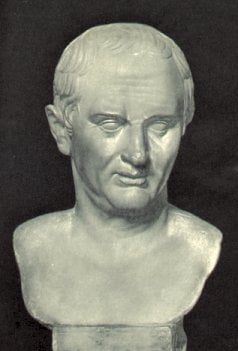
During the Hellenistic period, mythology became an elite knowledge that marked its possessors as belonging to a certain class. However, the skeptical turn of the Classical age became even more pronounced at this time.[24] For example, the Greek mythographer Euhemerus established the tradition of seeking an actual historical basis for mythical beings and events. Although his original work that made the contentions (Sacred Scriptures) is lost, much is known about it from what is recorded by Diodorus and Lactantius.[25]
Rationalizing the hermeneutics of myth became even more popular under the Roman Empire, thanks to the physicalist theories of Stoic and Epicurean philosophy. Indeed, the Stoics presented explanations of the gods and heroes as physical phenomena, the Epicureans argued that they were irrelevant to mortal existence, and the euhemerists rationalized them as historical figures. At the same time, the Stoics and the Neoplatonists, following the view of "Homer as culture" described above, promoted the moral significations of the mythological tradition.[26] Through his Epicurean message, Lucretius had sought to expel superstitious fears from the minds of his fellow-citizens.[27] Livy, too, is skeptical about the mythological tradition and claims that he does not intend to pass judgment on such legends (fabulae).[24]
The challenge for Romans with a strong and apologetic sense of religious tradition was to defend that tradition while conceding that it was often a breeding-ground for superstition. The antiquarian Marcus Terentius Varro, who regarded religion as a human institution with great importance for the preservation of good in society, devoted rigorous study to the origins of religious cults. In his (now lost) Antiquitates Rerum Divinarum, Varro argues that whereas the superstitious man fears the gods, the truly religious person venerates them as parents.[27] In his work, he distinguished three kinds of gods:
- The gods of nature: personifications of phenomena like rain and fire.
- The gods of the poets: invented by unscrupulous bards to stir the passions.
- The gods of the city: invented by wise legislators to soothe and enlighten the populace.
Cotta, a Roman academic, ridicules both literal and allegorical acceptance of myth, declaring roundly that myths have no place in philosophy. Cicero is also generally disdainful of myth, but, like Varro, he is emphatic in his support for the state religion and its institutions. It is difficult to know how far down the social scale this rationalism extended.[24] Cicero asserts that no one (not even old women and boys) would be so foolish as to be frightened by the terrors of Hades or the existence of Scyllas, centaurs or other composite creatures,[28] but, on the other hand, he complains elsewhere of the superstitious and credulous character of the people.[29] De Natura Deorum is the most comprehensive summary of this line of Cicero's thought.[27]
Modern interpretations
The reassessment of Greek mythology at the beginning of the modern era was prompted by a reaction against "the traditional attitude of Christian animosity" towards these tales, in which the Christian's viewed them as "lies" or fables.[30] In Germany, by about 1795, there was a growing interest in Homer and Greek mythology. In Göttingen, Johann Matthias Gesner began to revive Greek studies, while his successor, Christian Gottlob Heyne, worked with Johann Joachim Winckelmann and laid the foundations for mythological research both in Germany and elsewhere.[4]
Comparative and psychoanalytic approaches
The development of comparative philology in the nineteenth century, together with ethnological discoveries in the twentieth century, established myth as a suitable topic for scientific study. Indeed, since as early as the Romantic period, all study of myth has been comparative. From its beginnings in the mid-nineteenth century, Max Müller, Wilhelm Mannhardt, E. B. Tylor, Sir James Frazer, Stith Thompson, and Mircea Eliade (and many others) have employed the comparative approach to collect and classify the themes of folklore and mythology. In 1871 Edward Burnett Tylor published his Primitive Culture, in which he applied the comparative method and tried to explain the origin and evolution of religion.[31][32] Tylor's procedure of drawing together material culture, ritual and myth of widely separated cultures influenced both Carl Jung and Joseph Campbell. Max Müller applied the new science of comparative mythology to the study of myth, in which he detected the distorted remains of Aryan nature worship. Bronislaw Malinowski emphasized the ways myth fulfills common social functions. Claude Lévi-Strauss and other structuralists have compared the formal relations and patterns in myths throughout the world.
Sigmund Freud introduced a trans-historical and biological conception of man and a view of myth as an expression of repressed ideas. This Freudian interpretation uses dream interpretation as its primary methodological approach, stressing the importance of contextual relationships for the interpretation of any individual element in a dream. This suggestion would find an important point of rapprochement between the structuralist and psychoanalytic approaches to myth in Freud's thought.[33]
Carl Jung extended the trans-historical, psychological approach with his theory of the "collective unconscious" and the archetypes (inherited "archaic" patterns), often encoded in myth, that arise out of it.[5] According to Jung, "myth-forming structural elements must be present in the unconscious psyche."[34] Comparing Jung's methodology with Joseph Campbell's theory, Robert A. Segal concludes that "to interpret a myth Campbell simply identifies the archetypes in it. An interpretation of the Odyssey, for example, would show how Odysseus’s life conforms to a heroic pattern. Jung, by contrast, considers the identification of archetypes merely the first step in the interpretation of a myth."[32] Carl Kerenyi, one of the founders of modern studies in Greek mythology, gave up his early views of myth, in order to apply Jung's theories of archetypes to Greek myth.[4]
Motifs in western art and literature
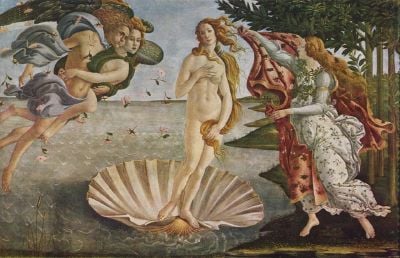
The widespread adoption of Christianity did not curb the popularity of the myths. With the rediscovery of classical antiquity in Renaissance, the poetry of Ovid became a major influence on the imagination of poets, dramatists, musicians and artists. From the early years of Renaissance, artists such as Leonardo da Vinci, Michelangelo, and Raphael, portrayed the pagan subjects of Greek mythology alongside more conventional Christian themes.[35] Likewise, these myths, through Ovid, influenced medieval and Renaissance poets such as Petrarch, Boccaccio, and Dante Alighieri.
In Northern Europe, Greek mythology never took the same hold of the visual arts, but its effect was very obvious on literature. The English imagination, starting with Chaucer and John Milton and continuing through Shakespeare and Robert Bridges, were fired by Greek mythology. Elsewhere on the continent, Racine (in France) and Goethe (in Germany) revived Greek drama, reworking the ancient myths into a contemporary mold. Although Enlightenment rationality dampened European esteem for mythical subject matter in the eighteenth century, they continued to provide an important source of raw material for dramatists, including those who wrote the libretti for many of Handel's and Mozart's operas.[35]
Moreover, the rise of Romanticism at the end of the eighteenth century initiated a surge of enthusiasm for all things Greek, including Greek mythology. Some notable names in this movement include Alfred Lord Tennyson, John Keats, Lord Byron, Percy Bysshe Shelley, Frederic Leighton and Lawrence Alma-Tadema.[35] Likewise, Christoph Gluck, Richard Strauss, Jacques Offenbach and many others set Greek mythological themes to music. This interest has continued unabated into the modern day, though many current sources syncretically incorporate materials from various mythological traditions.
Notes
- ↑ John Miles Foley, Homer's Traditional Art (Penn State University Press, 1999, ISBN 978-0271018706).
- ↑ Aeschylus, Prometheus Bound, 1080. Retrieved February 16, 2023.
- ↑ Aeschylus, Persians, 713. Retrieved February 16, 2023.
- ↑ 4.0 4.1 4.2 4.3 4.4 4.5 Fritz Graf, Greek Mythology: An Introduction (Johns Hopkins University Press, 1993, ISBN 978-0801853951).
- ↑ 5.0 5.1 5.2 5.3 "Greek Mythology," Encyclopaedia Britannica, 2002.
- ↑ 6.0 6.1 6.2 6.3 6.4 6.5 Geoffrey Miles (ed.), Classical Mythology in English Literature: A Critical Anthology (Routledge, 1999, ISBN 978-0415147545).
- ↑ 7.0 7.1 7.2 Antoine Brazouski and Mary J. Klatt, Children's Books on Ancient Greek and Roman Mythology: An Annotated Bibliography (Greenwood, 1993, ISBN 978-0313289736).
- ↑ 8.0 8.1 Ken Dowden, The Uses of Greek Mythology (Routledge, 1992, ISBN 0415061350).
- ↑ 9.0 9.1 9.2 Walter Burkert, Greek Religion: Archaic and Classical (Blackwell Publishing, 1991, ISBN 0631156240).
- ↑ Hesiod, Works and Days, 90-105. Retrieved February 16, 2023.
- ↑ Ovid, Metamorphoses, I, 89-162. Retrieved February 16, 2023.
- ↑ 12.0 12.1 Hesiod, Theogony, 116-138.
- ↑ Hesiod, Theogony, 713-735.
- ↑ Homeric Hymn to Hermes, 414-435.
- ↑ 15.0 15.1 Heinrich Wilhelm Stoll, Handbook of the Religion and Mythology of the Greeks (Sagwan Press, 2015, ISBN 978-1296920159).
- ↑ Gregory Nagy, Greek Mythology and Poetics (Cornell University Press, 1992, ISBN 978-0801480485).
- ↑ Ovid's Metamorphoses provides one of the most complete catalogues of this type of tale.
- ↑ John B. Weaver, Plots of Epiphany (De Gruyter, 2012, ISBN 978-3110182668).
- ↑ 19.0 19.1 Francis Willey Kelsey, An Outline of Greek and Roman Mythology (Wentworth Press, 2019, ISBN 978-0526706969).
- ↑ Carla M. Antonaccio, "Contesting the Past: Hero Cult, Tomb Cult, and Epic in Early Greece," American Journal of Archaeology 98(3) (July 1994): 389-410.
- ↑ Herbert J. Rose, A Handbook of Greek Mythology (Routledge, 1990, ISBN 978-0415046015).
- ↑ 22.0 22.1 22.2 Victor Davis Hanson and John Heath, Who Killed Homer (Encounter Books, 2001, ISBN 1893554260).
- ↑ 23.0 23.1 23.2 John Boardman, Jasper Griffin, and Oswyn Murray (eds.), "Greek Myth and Hesiod," The Oxford Illustrated History of Greece and the Hellenistic World (Oxford University Press, 2001, ISBN 0192854380).
- ↑ 24.0 24.1 24.2 Monica R. Gale, Myth and Poetry in Lucretius (Cambridge University Press, 1994, ISBN 978-0521451352).
- ↑ Robin Hard, The Routledge Handbook of Greek Mythology (Routledge, 2003, ISBN 978-0415186360).
- ↑ Jane Chance, Medieval Mythography (University Press of Florida, 1994, ISBN 978-0813012568).
- ↑ 27.0 27.1 27.2 Cicero, Patrick G. Walsh (trans.), The Nature of the Gods (Oxford University Press, 2008, ISBN 978-0199540068).
- ↑ Cicero, Tusculanae Disputationes, 1.11. Retrieved February 16, 2023.
- ↑ Cicero, De Divinatione, 2.81. Retrieved February 16, 2023.
- ↑ Robert Ackerman, "Introduction," Jane Ellen Harrison, Prolegomena to the Study of Greek Religion (Princeton University Press, 1991, ISBN 0691015147).
- ↑ Douglas Allen, Structure and Creativity in Religion (Walter de Gruyter, 1978, ISBN 9027975949).
- ↑ 32.0 32.1 Robert A. Segal, Theorizing about Myth (University of Massachusetts Press, 1999, ISBN 1558491910).
- ↑ Lowell Edmunds, (ed.), Approaches to Greek Myth (Johns Hopkins University Press, 1990, ISBN 978-0801838644).
- ↑ Carl Gustav Jung and Carl Kerenyi, Essays on a Science of Mythology (Princeton University Press, 1969, ISBN 978-0691017563).
- ↑ 35.0 35.1 35.2 Lucilla Burn, Greek Myths (University of Texas Press, 1990, ISBN 978-0292727489).
ReferencesISBN links support NWE through referral fees
- Allen, Douglas. Structure and Creativity in Religion. Walter de Gruyter, 1978. ISBN 9027975949
- Betegh, Gábor. The Derveni Papyrus. Cambridge University Press, 2004. ISBN 0521801087
- Brazouski, Antoine, and Mary J. Klatt. Children's Books on Ancient Greek and Roman Mythology: An Annotated Bibliography. Greenwood, 1993. ISBN 978-0313289736
- Boardman, John, Jasper Griffin, and Oswyn Murray (eds.). The Oxford Illustrated History of Greece and the Hellenistic World. Oxford University Press, 2001. ISBN 0192854380
- Burkert, Walter. Greek Religion: Archaic and Classical. Blackwell Publishing, 1991. ISBN 0631156240
- Burn, Lucilla. Greek Myths. University of Texas Press, 1990. ISBN 978-0292727489
- Chance, Jane. Medieval Mythography. University Press of Florida, 1994. ISBN 978-0813012568
- Cicero, Patrick G. Walsh (trans.). The Nature of the Gods. Oxford University Press, 2008. ISBN 978-0199540068
- Dowden, Ken. The Uses of Greek Mythology. Routledge, 1992. ISBN 0415061350
- Edmunds, Lowell (ed.). Approaches to Greek Myth. Johns Hopkins University Press, 1990. ISBN 978-0801838644
- Foley, John Miles. Homer's Traditional Art. Penn State University Press, 1999. ISBN 978-0271018706
- Gale, Monica R. Myth and Poetry in Lucretius. Cambridge University Press, 1994. ISBN 978-0521451352
- Graf, Fritz. Greek Mythology: An Introduction. Johns Hopkins University Press, 1993. ISBN 978-0801853951
- Hanson, Victor Davis, and John Heath, Who Killed Homer Encounter Books, 2001. ISBN 1893554260
- Hard, Robin. The Routledge Handbook of Greek Mythology. Routledge, 2003. ISBN 978-0415186360
- Harrison, Jane Ellen. Prolegomena to the Study of Greek Religion. Princeton University Press, 1991. ISBN 0691015147
- Jung, Carl Gustav, and Carl Kerenyi. Essays on a Science of Mythology. Princeton University Press, 1969. ISBN 978-0691017563
- Kelsey, Francis Willey. An Outline of Greek and Roman Mythology. Wentworth Press, 2019. ISBN 978-0526706969
- Miles, Geoffrey (ed.). Classical Mythology in English Literature: A Critical Anthology. Routledge, 1999. ISBN 978-0415147545
- Nagy, Gregory. Greek Mythology and Poetics. Cornell University Press, 1992. ISBN 978-0801480485
- Rose, Herbert J. A Handbook of Greek Mythology. Routledge, 1990. ISBN 978-0415046015
- Segal, Robert A. Theorizing about Myth. University of Massachusetts Press, 1999. ISBN 1558491910
- Stoll, Heinrich Wilhelm. Handbook of the Religion and Mythology of the Greeks. Sagwan Press, 2015. ISBN 978-1296920159
- Weaver, John B. Plots of Epiphany. De Gruyter, 2012. ISBN 978-3110182668
External links
All links retrieved February 11, 2023.
- Theoi Project, Guide to Greek Mythology – Contains stories of gods and monsters with quotes from original sources and images from classical art
- Timeless Myths: Classical Mythology – Provides information and tales from classical literature
Greek and Roman literature
- Aeschylus, The Persians. Available online from Perseus Digital Library, Tufts University.
- Aeschylus, Prometheus Bound. Available online from Perseus Digital Library, Tufts University.
- Apollodorus, Library and Epitome. Available online from Perseus Digital Library, Tufts University.
- Apollonius of Rhodes, Argonautica, Book I. Available online from Sacred-Texts.com.
- Cicero, De Divinatione. Available online from The Latin Library.
- Cicero, Tusculanae Disputationes. Available online from TheLatin Library.
- Herodotus, The Histories, I. Available online from Sacred-Texts.com.
- Hesiod, Works and Days. Translated by Hugh G. Evelyn-White. Available online from Sacred-Texts.com.
- Hesiod, Theogony. Available online from Perseus Digital Library, Tufts University.
- Homer, Iliad. Available online from Perseus Digital Library, Tufts University.
- Homeric Hymn to Demeter. Available online from Perseus Digital Library, Tufts University.
- Ovid, Metamorphoses. Available online from The Latin Library.
- Plato, Apology. Available online from Perseus Digital Library, Tufts University.
Credits
New World Encyclopedia writers and editors rewrote and completed the Wikipedia article in accordance with New World Encyclopedia standards. This article abides by terms of the Creative Commons CC-by-sa 3.0 License (CC-by-sa), which may be used and disseminated with proper attribution. Credit is due under the terms of this license that can reference both the New World Encyclopedia contributors and the selfless volunteer contributors of the Wikimedia Foundation. To cite this article click here for a list of acceptable citing formats.The history of earlier contributions by wikipedians is accessible to researchers here:
The history of this article since it was imported to New World Encyclopedia:
Note: Some restrictions may apply to use of individual images which are separately licensed.
